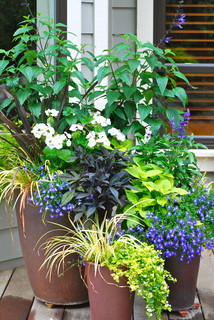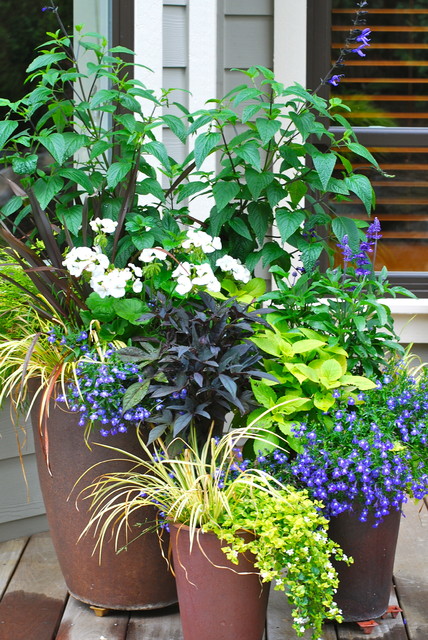Including nectar- and pollen-rich plants in potted displays can help support the native birds, butterflies and bees in your neighborhood. While pollinators require more than just a food source for survival — they’ll also need water, native plants for laying eggs, habitat for roosting and more — supplying our winged friends with a place to stop for a meal can help support them, particularly in food-scarce urban environments.
Take a look at these nine potted displays that all include at least one flowering plant guaranteed to attract bees, butterflies or hummingbirds — or even all three. Could you see one of them on your patio or balcony?
Take a look at these nine potted displays that all include at least one flowering plant guaranteed to attract bees, butterflies or hummingbirds — or even all three. Could you see one of them on your patio or balcony?
Design tip: Plant in swaths. To make it easy on pollinators, group plants they like in clumps and swaths. Imagine being insect-sized flying over an urban landscape. It would be far easier for you to spot a large purple clump of flowering lavender than a single plant. Once you reached the lavender swath, it would make for efficient foraging.
In this rooftop lounge area by Hampstead Garden Design, masses of salvia (Salvia nemorosa ‘Caradonna’) and lavender (Lavandula angustifolia ‘Hidcote’) come together for a beautiful pollinator-friendly planting. If you don’t have room for a full swath of pollinator-friendly potted plants, including some as part of mixed ornamental containers is still beneficial.
Work with a landscape designer on Houzz
In this rooftop lounge area by Hampstead Garden Design, masses of salvia (Salvia nemorosa ‘Caradonna’) and lavender (Lavandula angustifolia ‘Hidcote’) come together for a beautiful pollinator-friendly planting. If you don’t have room for a full swath of pollinator-friendly potted plants, including some as part of mixed ornamental containers is still beneficial.
Work with a landscape designer on Houzz
4. Purple Verbena
With tall, wispy stems and flowers so rich in nectar that they smell like honey, tall purple verbena (Verbena bonariensis), also called vervain, is a great plant to consider adding to containers for pollinators. Plus, it adds height and movement to potted displays, as stems sway with the slightest breeze.
In this Boston rooftop garden, landscape designer Jean Brooks tucked tall purple verbena into the back of containers filled with billowing annuals and ‘Ascot Rainbow’ spurge (Euphorbia x martinii ‘Ascot Rainbow’).
Water requirement: Moderate
Light requirement: Full sun
With tall, wispy stems and flowers so rich in nectar that they smell like honey, tall purple verbena (Verbena bonariensis), also called vervain, is a great plant to consider adding to containers for pollinators. Plus, it adds height and movement to potted displays, as stems sway with the slightest breeze.
In this Boston rooftop garden, landscape designer Jean Brooks tucked tall purple verbena into the back of containers filled with billowing annuals and ‘Ascot Rainbow’ spurge (Euphorbia x martinii ‘Ascot Rainbow’).
Water requirement: Moderate
Light requirement: Full sun
6. Coneflowers
Long-blooming perennial coneflowers (Echinacea spp.) provide a steady stream of food to pollinators from late summer until the first frost, when most warm-season flowers are becoming more scarce.
In this bright combination, landscape designer Courtney Olander of Olander Garden Design combined hot-colored coneflowers with bronze-leafed coral bells (Heuchera sp.), ‘Ascot Rainbow’ spurge (Euphorbia x martinii ‘Ascot Rainbow’) and trailing purple sweet potato vines (Ipomoea batatas).
Water requirement: Moderate to regular
Light requirement: Full sun
Long-blooming perennial coneflowers (Echinacea spp.) provide a steady stream of food to pollinators from late summer until the first frost, when most warm-season flowers are becoming more scarce.
In this bright combination, landscape designer Courtney Olander of Olander Garden Design combined hot-colored coneflowers with bronze-leafed coral bells (Heuchera sp.), ‘Ascot Rainbow’ spurge (Euphorbia x martinii ‘Ascot Rainbow’) and trailing purple sweet potato vines (Ipomoea batatas).
Water requirement: Moderate to regular
Light requirement: Full sun
7. Catmint
In this Chelsea rooftop garden in New York City, mounds of potted purple-blue catmint (Nepeta sp.) beckon to pollinators, inviting them to pause and refuel in this oasis in the city. The garden, designed by Brook Klausing of BROOK LANDSCAPE, includes dozens of potted plants: evergreens, ornamental grasses, hydrangeas, smoke bush (Cotinus sp.) and more.
Catmint generally stays small and mounded, making it a great edger plant to tuck around the bases of larger containers in sunny spots or along the side of a raised bed.
Water requirement: Moderate to regular
Light requirement: Full sun
In this Chelsea rooftop garden in New York City, mounds of potted purple-blue catmint (Nepeta sp.) beckon to pollinators, inviting them to pause and refuel in this oasis in the city. The garden, designed by Brook Klausing of BROOK LANDSCAPE, includes dozens of potted plants: evergreens, ornamental grasses, hydrangeas, smoke bush (Cotinus sp.) and more.
Catmint generally stays small and mounded, making it a great edger plant to tuck around the bases of larger containers in sunny spots or along the side of a raised bed.
Water requirement: Moderate to regular
Light requirement: Full sun
Follow Hashtags: #AnitaMadisonRealtor #ColdwellBanker #NoCalRealEstate #LuxuryHomes

 Anita Madison
Anita Madison 














This container by
Simply Garden Design combines two types of Salvia — a pollinator favorite — along with chartreuse and dark purple sweet potato vines (Ipomoea batatas), grass-like sedge, New Zealand flax(Phormium sp.), blue lobelia, white geraniums and trailing bacopa. The taller salvia (Salvia guaranitica ‘Black and Blue’) has longer, tubular flowers that attract hummingbirds.
Honeybees have small bodies and longer tongues than solitary bees, allowing them to reach the nectar as well. Solitary bees may bite the base of the flower to access the nectar reservoir.
The more compact blue salvia (Salvia farinacea) has smaller, more shallow flowers that allow a broader range of pollinators to collect nectar from the blooms.
Water requirement: Moderate to regular
Light requirement: Partial to full sun